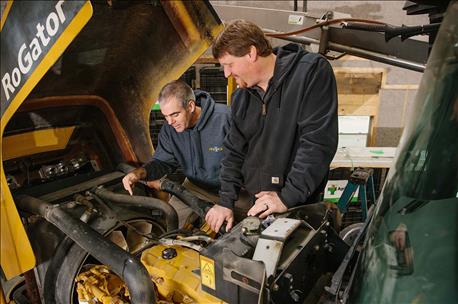February 12, 2016

Equipment has slowly been cycling through the shop. Coming soon on the list are the planters. A couple weeks ago we attended a planter clinic. At the meeting, presenters walked through the entire planting process and highlighted areas that could be improved. Of course, everything was at a price, but supposedly comes with more bushels.
I am convinced that hydraulic down force is the way to go. Many of our fields go from sand to clay or muck. I’m sure there are times when we are using too much pressure and pushing seed too deep. This is mainly because we set the planter to put the seed in the ground in tougher or rougher conditions.

Kyle Stackhouse (left) and mechanic Stan Murphy diagnose a mechanical issue at the Stackhouse farm. Read about the pros and cons of DIY repairs in the Feb. 2016 issue of Farm Futures.
The downside is the cost -- about $1,000 a row. I am also not excited about more integrated technology. It is just one more thing to go wrong when it is go time. I don’t think it’s going to happen this year.
We are also considering changing our row wipers. For years we have done a good job with stationary row mount units. The last few years, floating wipers have been the center of discussion. Now there is a model out that is mounted in such a way that the wiper is pulled rather than being pushed. The pulling motion should run smoother and not gouge the ground. Additionally, an air cylinder can be mounted in lieu of a spring. Pressure can then be adjusted from the cab.
It is a strong possibility that this will happen this year. We should probably get the order in very quickly as many times product shortages surface after the Louisville farm show.
Pop up fertilizer
Last year, we were not happy with the delivery of pop-up fertilizer. We found out that low salt doesn’t mean low salt. In some sandy fields we experienced stand reduction. We have changed formulations for this year, but are still evaluating method of delivery. At this point, we haven’t found anything that seems substantially better than in furrow. We are going to continue investigating this area.
A rather convincing presentation was also made about tire pressure, compaction and tire wear. Sometimes it is good to have a reminder. We really should be changing pressures when swapping implements and when going from transport to field work and vice versa. The problem comes in practical application. They presented a system that would adjust pressure at the push of a button. I didn’t ask the price, but I can see a good fit on sprayers and high clearance applicators where you need high tire pressure to run down the road loaded, but compaction would be reduced if pressure was dropped when you arrive in the field.
A related side note: tracks are now available to replace center frame wheel assemblies on planters. Center fill planters put a lot of weight on those tires and create pinched rows. I put a set of those at the top of my list, but none are available for our planter at this time.
About the Author(s)
You May Also Like






